Church Introduces Hearing Loop Technology to Congregation for an Inclusive Worship Experience
Waco, TX — First Presbyterian Church in Waco has taken a step towards ensuring an inclusive worship experience for all its members by introducing a state-of-the-art hearing loop system to the worship experience. The hearing loop installation provides clear audibility of sermons, scripture readings, and music, benefiting all congregants with hearing loss.
With a strong commitment to embracing modern technology and prioritizing inclusivity, the church has created an environment where everyone can fully engage in the worship experience.
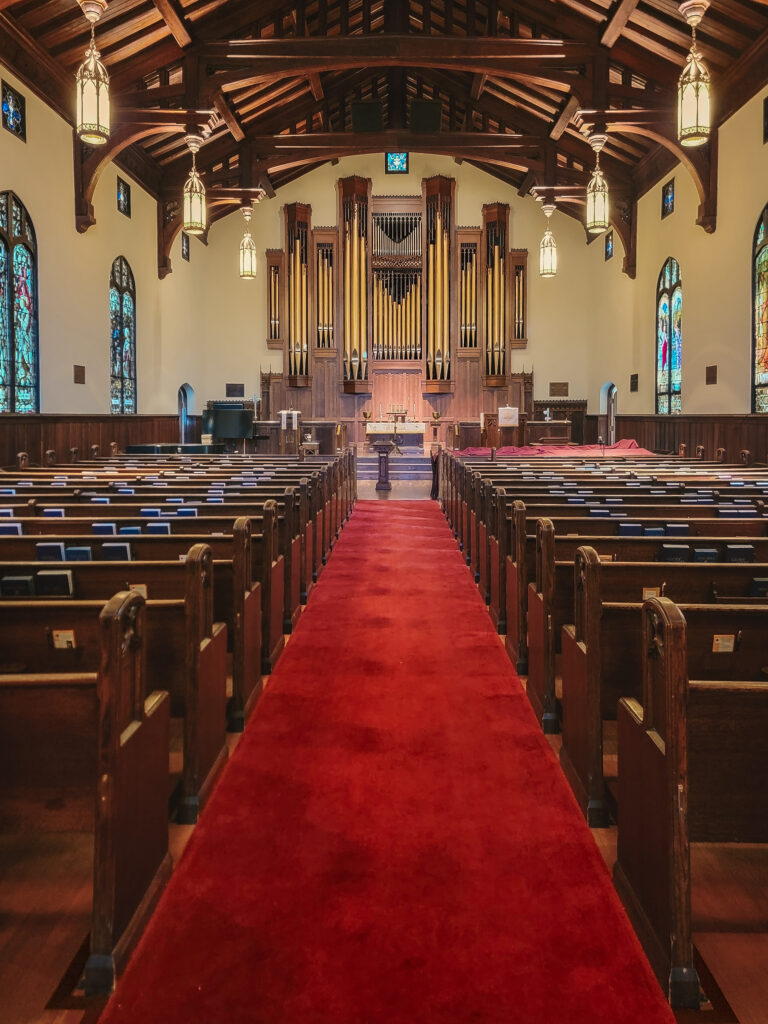
Merging History with Modern Technology
The hearing loop system is in the sanctuary of First Presbyterian Church, a building that dates back to 1911. The hearing loops wiring discreetly integrates into the existing church decor and preserves the architectural integrity of the 112-year-old building. The installation of hearing loop technology provides an excellent example of the utilization of modern technology to enhance one’s experience in a historic venue.
“Churches often don’t realize that a hearing loop can be be integrated into a historic building relatively easily and generally without disrupting the existing décor. The architectural elements of historic churches – high ceilings, wood pews, hard surfaces – make it extremely difficult to hear, regardless of whether you wear a hearing aid or not. For people with hearing loss, it can make it virtually impossible to hear,” shares Erin Nichols, owner of Assist2Hear, whose company installed the hearing loop. “The good news is that this issue can be mitigated with the use of hearing assistive technology.”
Hearing Loops Foster Inclusivity in Worship
The new hearing loop installation not only increases inclusivity for worshipers at First Presbyterian Church, but it also enhances the sense of community within the church. When the congregation gathers to worship, they know that everyone can participate in the worship experience, regardless of their auditory capabilities.
“It is a delight to witness the positive impact of the hearing loop installation in each congregation that we install in,” says Ms. Nichols. “First Presbyterian Church’s dedication to inclusivity sets an inspiring example for other places of worship and the city of Waco.”
Come and Listen for Yourself!
First Presbyterian Church is located at 1100 Austin Avenue in Waco, TX. Join them in person for services at 8:30 AM or 10:30 AM each Sunday, or on their FirstPres Waco Youtube channel.
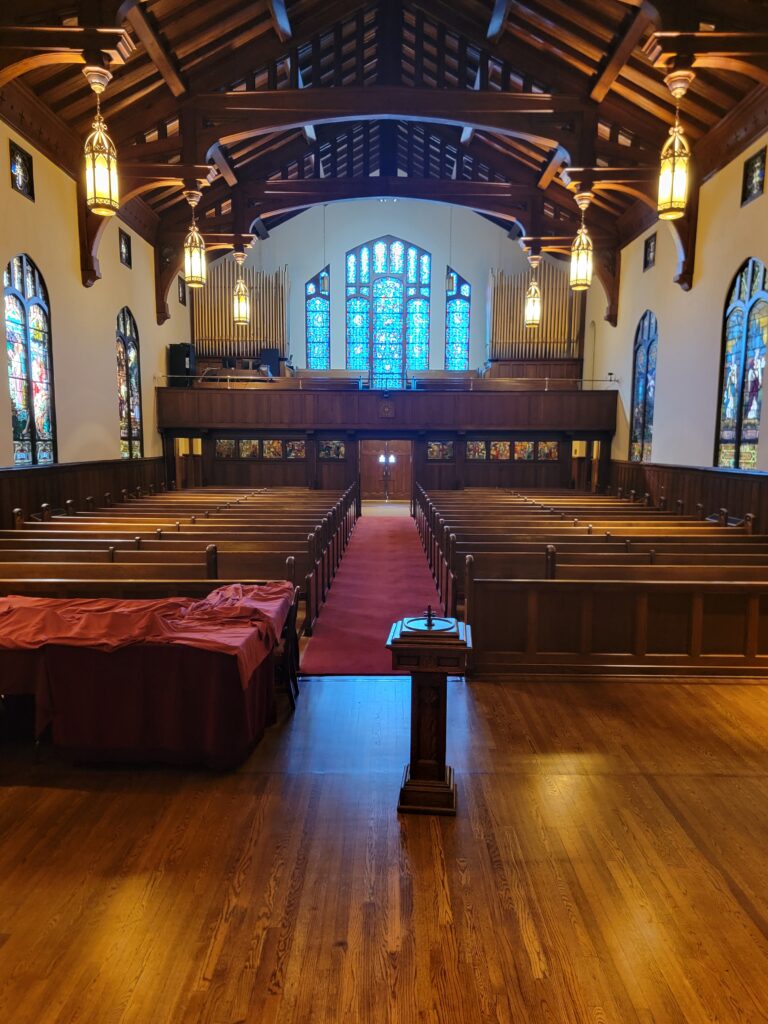
Draw Seasonal Visitors Back into the Flock
Churches can expect an influx of visitors, in addition to their regular attendees, during the Easter season. According to Senior Pastor Central, more than likely 25% of all visitors to a church annually will come for Easter services. This is an excellent opportunity to promote your church’s hearing loop, helping ensure regular attendees and guests with hearing loss enjoy your Easter services.
A hearing loop signifies to attendees that all are truly welcome in your church community. Make this message loud and clear by taking the following easy steps to promote your hearing loop during the Easter season:
- Briefly explain hearing loop technology before the start of services and remind attendees to turn on their telecoil program.
- Promote the presence of your hearing loop in your church bulletin.
- Add a slide with hearing loop information to your PowerPoints (if used).
- Assign a point person to help answer questions about the system and/or assist with loop receivers before the service.
- Have extra receivers on hand. Assist2Hear is happy to help you with additional receiver purchase or rental if needed.
A hearing loop is a true blessing for people with hearing loss! It significantly enhances the church experience by providing clarity to every word spoken. Most notably, hearing loops filter out the echo, reverberation, and background noise that traditionally make it difficult to hear the sermon in church. Attendees with or without hearing aids can utilize the hearing loop system.
The Easter season is a prime opportunity to promote the hearing loop to your attendees and guests, offering them an enhanced worship experience. By actively promoting your hearing loop, you are also increasing the odds of turning an Easter visitor into a regular attendee!

First United Methodist Church Installs New Hearing Loop
For those living with hearing loss, attending religious services can often be a challenging experience. In Cheyenne, the First United Methodist Church has taken a step towards making worship more accessible. After much research, the church decided that hearing loop technology would be the best fit to improve hearing accessibility. They chose Assist2Hear to install a hearing loop system for worshippers – the newest hearing loop in Cheyenne, Wyoming.
What is a Hearing Loop System?
An induction hearing loop system (also known as an “assistive listening loop”) uses magnetic induction to transmit sound directly to hearing aids or hearing implants equipped with telecoil (T-coil) technology. The majority of hearing devices have a telecoil program available, but users are often unaware it exists until they ask their hearing professional to activate it. For worshipers without a telecoil-enabled hearing device, receivers with headsets or earbuds are available to use.
How the Hearing Loop System Was Installed
The Cheyenne church underwent several tests by Assist2Hear to ensure optimal hearing loop installation. These included surveys of construction and materials transitions, tests for electrical magnetic interference, metal loss, and frequency variation. The architecture of the church divides the sanctuary into three distinct segments – a wide semi-circular set of pews in the front half, two sets of narrower rectangular pews in the back half, and the choir. To ensure accessibility for all, the church chose to install the hearing loop system in all three sections. As a result, every worshipper with hearing loss is able to benefit from the hearing loop, regardless of where they sit!
Each section’s unique layout and flooring characteristics required the use of a different design and installation technique. A figure eight loop design using flat wire installed underneath the carpet covers the back section. The front segment’s construction and narrowness allowed for a perimeter loop with the wire hidden behind the trim of the wall. The choir, located behind the altar, was installed using a mix of wire types to disguise the wire. All systems feed to the audio booth located in the sanctuary. Assist2Hear chose Contacta, Inc hearing loop amplifiers for the installation, as they are the highest quality product on the market today.
Rave Reviews for the Hearing Loop System
The new Cheyenne hearing loop has received much positive feedback from church members. They report that the sound is clear and it is much easier to understand the sermon. Additionally, congregants with hearing loss also note how much easier it is to listen easily and enjoy the sermon. The new hearing loop is truly a blessing to their ears!
First United Methodist’s Tradition of Inclusivity
The church has a long history of being a welcoming environment for members of the Cheyenne community. The church dates its history back to just a few months after the city of Cheyenne came into existence. In 2017, the church celebrated its 150th anniversary. With the installation of the new hearing loop system, the oldest Methodist church in Wyoming continues its legacy of being a pioneer!
If you are looking for a church in Cheyenne that is hearing loss friendly, the First United Methodist Church is an excellent choice. With its long history rooted in the Cheyenne community, the church provides a welcoming environment for all. Come and experience the benefits of hearing loop technology at the First United Methodist Church in Cheyenne, Wyoming!
Hearing loops are present in Methodist churches throughout the United States. To locate other hearing loops by Assist2Hear, check out the hearing loop installations page on www.Assist2Hear.com.

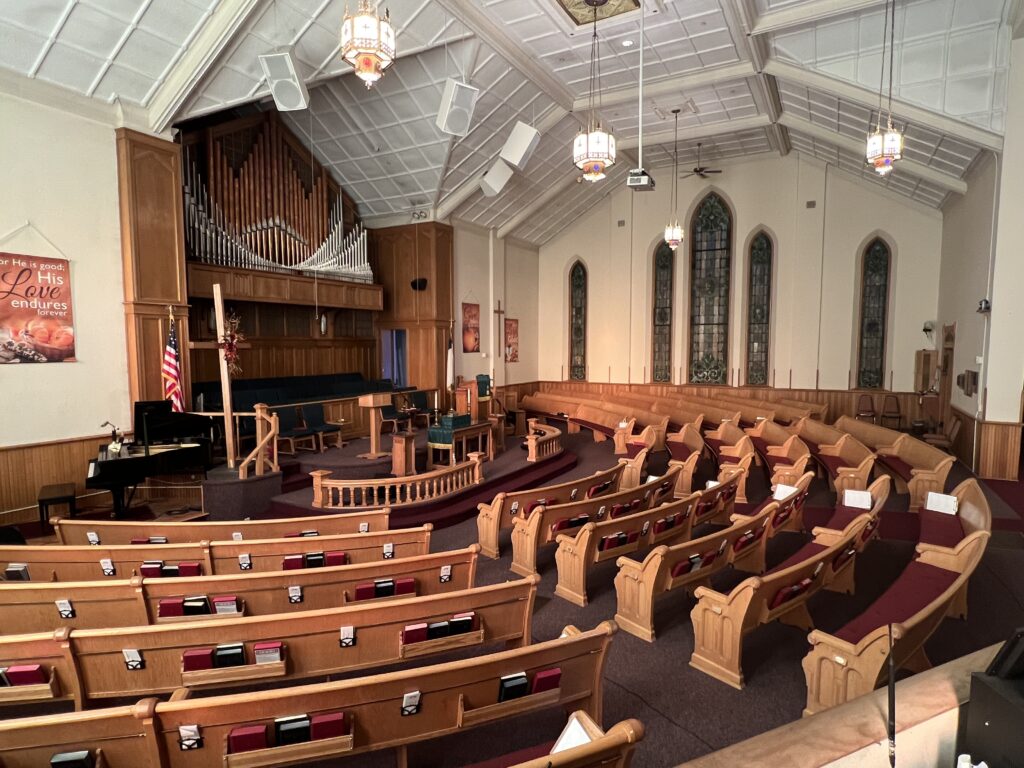


Trinity Church in Fredericksburg Installs Hearing Loop
The charming town of Fredericksburg, TX is now even more lovely thanks to the addition of a new hearing loop within the community. The new Fredericksburg hearing loop is at Trinity Church, located across from the Circle E Candle Factory, approximately 2 miles east of town, at 157 Schmidtzinsky Road. The town of Fredericksburg itself is located in the wine country just outside Austin. Today, the town is known for both its wine production, as well its uniquely German flair, an homage to the town’s early settlers. The church, formerly known as Fredericksburg Fellowship Christian Church, chose Assist2Hear to install the hearing loop system.
Hearing Loop Installation Experience Counts
Dark brown wood and historic-looking white walls are the hallmarks of the sanctuary at Trinity Church. The architecture and décor of the sanctuary is, of course, very German – high-quality wood, well-constructed and traditional, with clean lines. Trinity’s flooring consists of beautiful dark brown wood planks that run perpendicular to the pews and the ceiling is cavernous. Installing a hearing loop in a distinctive location such as this requires a variety of different techniques to hide or disguise wiring.
In spaces with similar size and layout, a minimum of a figure-eight loop design is necessary to ensure the end product is IEC-compliant. Anything less in a space this wide will generally result in “dead” spots, highly variable, or low sound for the user. Unfortunately, in hearing loop land, it is extremely rare to be able to just “run a wire around a room” and have a street-legal hearing loop. To minimize the disturbance to the church’s decor during the installation, the many years of design and installation experience of Assist2Hear team paid off.
“Most installers would not have taken this job, simply because of the wood flooring,” said Richard, Assist2Hear lead installer. “We have worked with so many historical churches and buildings over the years now though that we can figure out how to install a hearing loop anywhere and make it hidden. The way the materials used on the floor blended with the wood floor in this job far kind of blew my mind though -– it looks phenomenol!”
Visiting Fredericksburg
Founded in 1946 by German settlers, today the town of Fredericksburg continues to embrace its historic German heritage. German restaurants, bed & breakfasts, and wineries abound. The town is also notably home to the National Museum of the Pacific War, named after Fredericksburg native, Chester A. Nimitz. The museum is a must-visit for history buffs!
A visit to Fredericksburg, TX is definitely worth one’s time. Take heed though – throngs of tourists and weekenders arrive toward the middle and end of the week. For a quieter and more navigable experience, visit earlier in the week. To quote the locals, “the weekend starts on Wednesday in Fredericksburg”.
Tourism being the primary industry, it is expected that both locals and visitors will benefit from the new Fredericksburg hearing loop at Trinity Church!


People with hearing loss have the best sound in the house at Parker Presbyterian!
Parker Evangelical Presbyterian Church in Parker, Colorado recently installed a hearing loop, making it the most recent church in Colorado to “get in the loop”. Congregation members with hearing loss can now have the sermon broadcast directly to their ears via a hearing loop. Parker Evangelical Presbyterian Church, located at 9030 Miller Road, Parker CO 80138, chose to install a hearing loop during a larger renovation of the sanctuary. The renovation included new carpet, a new seating arrangement, and a hearing loop. The hearing loop installation occurred immediately prior to the new carpet installation.
The Project
The idea for the hearing loop project initially came via a recommendation from a member of the congregation. It became evident to the building committee that many people in the congregation would benefit from a hearing loop. Moving forward, a member of the building project committee spearheaded the vendor search and selection process. The vetting process included speaking with other Presbyterian congregations that hearing loops. After speaking with several happy Assist2Hear customers, Assist2Hear was selected to design and install the hearing loop system at Parker Evangelical Presbyterian Church.
There are always many moving parts during a renovation project, Parker Presbyterian being no exception. In this example, the hearing loop installation was to occur immediately prior to the new flooring installation. Material delays caused the project to be pushed back by several months. Once the material arrived, the church Facilities Manager, Cliff, performed the demolition of the existing carpet in the sanctuary. The demo turned out to be quite a task, involving a significant amount of scraping, sanding, and even an ATV! Finally, a last-minute change in the flooring finish underneath the pews required a modified materials approach by Assist2Hear.
How Does a Hearing Loop Work?
Hearing loops transmit sound directly to a user’s hearing aid, without the use of additional receivers or other equipment. Hearing aid wearers simply change their hearing device to the telecoil (t-coil) or M-1 program in order to do so. The telecoil program is very common in hearing aids. The Hearing Loss Association of America cites that approximately 81% of hearing aids and 100% of Cochlear implants currently have the telecoil option available in them.
Each hearing loop system is designed specifically for the location in which it is to be installed. At Parker Presbyterian, a “phased array” design is being used to ensure a consistent sound for the user, regardless of their orientation in the sanctuary. A phased array design selection is also appropriate to limit the spill of the system onto the main worship platform, where a bevy of instrumentation is frequently used.
Other Parker Hearing Loops
Residents and visitors to Parker Colorado can enjoy hearing loops throughout Parker and the nearby South Denver communities. Most notably, the Parker Library, which has two hearing loops for public use in its upstairs community rooms. In fact, residents of Douglas County can enjoy hearing loops in every library within the Douglas County library system! Another nearby hearing loop is the Lone Tree Performing Arts Center, a state-of-the-art, 350-seat theater in nearby Lone Tree.
Assist2Hear is happy to help you learn more about the cost of a hearing loop installation in your church. Submit an inquiry online today at www.assist2hear.com
Norman residents with hearing loss can now participate with ease in Norman City Council meetings
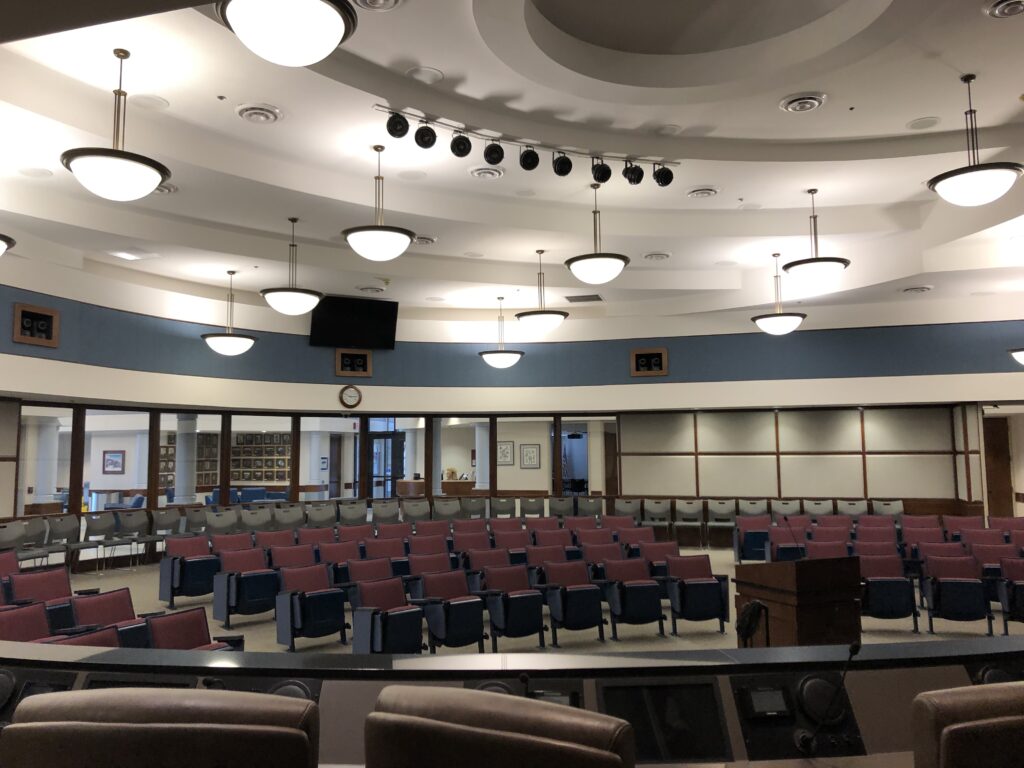
Citizens with hearing loss in the city of Norman, Oklahoma can now hear better in city council meetings thanks to the installation of a hearing loop system! The city of Norman chose to install the hearing loop during the recent remodel of the Norman City Council Chambers. The new hearing loop will allow citizens to hear every word of the city council meetings with ease and clarity. Attendees can bring the sound from the council person’s microphones directly to their ear using their hearing aid’s telecoil program. Assist2Hear, Inc., a leading national installer of hearing loop systems, installed the Norman City Council hearing loop.
The hearing loop covers the entirety of the Norman City Council chambers, including all public seating and the dais. This means that both the public and the members of Norman City Council can benefit from the hearing loop system.
A hearing loop system is also present now in the small meeting room located at Norman City Hall. A phased array design in both spaces allows for meeting privacy, as well as ensures a uniform sound for users.
“Privacy and seating orientation are key considerations when designing a hearing loop system,” says Erin Nichols, the head loop engineer for Assist2Hear. “In this space, privacy was important. Both spaces have considerable seating around the perimeter, which was important to consider in the design phase. Less experienced installers might have chosen to just ‘run a wire around the room’ in the smaller meeting room. This might have been easier, but it would not have met the customer’s needs, and users seated along the edge of the room would have had poor signal, in addition to a huge amount of spill leaking through the walls!”
Most citizens who use the new Norman City Hall hearing loops will simply change to the “telecoil” program on their own hearing aid to use the system. According to the Hearing Loss Association of America, 81% of hearing aids on the market today have a telecoil in them or a telecoil option. 100% of implants such as Cochlears contain a telecoil. If someone does not have a hearing aid or does not know if their hearing aid has a telecoil in it, hearing loop receivers and headsets are available at the information desk located just outside the city council chambers.
Residents of the city of Norman can also enjoy hearing loops at the following locations:
- Norman Central Library
- St. Thomas Moore Catholic Church
- St. John’s Episcopal Church
Any venue looking to explore hearing loop technology can receive a free quote through Assist2Hear. To do so, a form is available on their website, www.Assist2Hear.com.
Another Methodist Church Gets in the Loop!
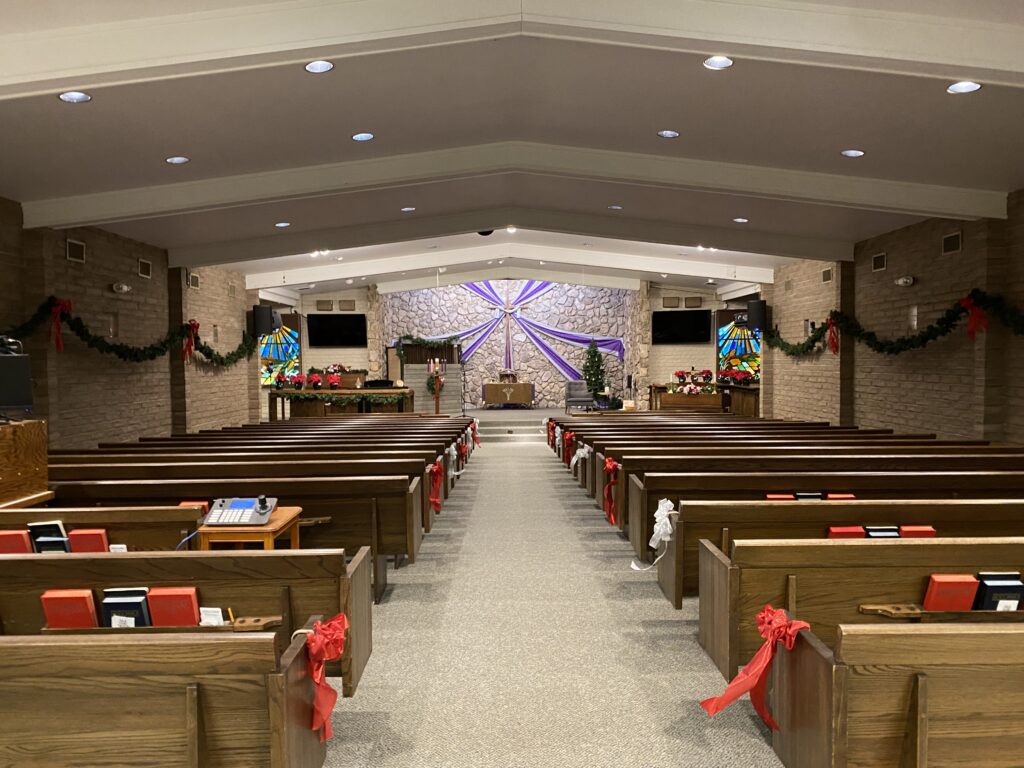
Assist2Hear is pleased to announce that yet another United Methodist church has chosen to install a hearing loop! This past Easter Sunday, congregation members with hearing loss at the United Methodist Church of Johnstown got to enjoy the Word clearly and easily via the new hearing loop system. The church is located at 108 King Avenue in Johnstown, Colorado.
The hearing loop installation was a stand-alone project for the church. This means the loop was installed as a retrofit, not during a time of new construction or a remodel. To install the hearing loop in the church, carpet modification and restoration were necessary. All installation services – hearing loop wiring and carpet work – are performed by Assist2Hear employees. In doing so, Assist2Hear is able to make system installation affordable for customers.
How to Use the Hearing Loop
The hearing loop system is accessible for all worshippers, regardless of whether or not they use a hearing aid; however, the majority of hearing loop users will listen with their own telecoil-enabled hearing aid. To use the hearing loop, a user simply changes their hearing aid to the “telecoil” or “M1” program. Additionally, hearing loop receivers and headsets are available for use for those without hearing aids or telecoils. Attendees who need a receiver can pick one up at the audio booth, located in the rear of the church sanctuary. If someone is unsure if their hearing aid has a telecoil program, giving their audiologist a call can help clarify.
A Unique Church History
The United Methodist Church of Johnstown has a long and colorful history in Colorado. In 1903, the church merged with a local Episcopal congregation to become the first United Methodist church west of the Mississippi! Today, the engaged and friendly congregation is led by Pastor Jeremy Scott. For more information on the United Methodist Church of Johnstown, its many methods of outreach to the community, and the schedule of services, please visit its website at www.johnstown.church.
Hearing Loops in the United Methodist Faith
The United Methodist faith is deeply committed to making worship accessible to congregation members with hearing loss. United Methodist churches with hearing loops can be found throughout the nation. Assist2Hear has installed many hearing loops within the faith. Some of these hearing loop installations include:
- St. Andrews United Methodist Church (Highlands Ranch, CO)
- Littleton United Methodist Church (Littleton, CO)
- Washington Park United Methodist Church (Denver, CO)
- Boston Avenue United Methodist Church (Tulsa, OK)
- Asbury United Methodist Church (Tulsa, OK)
For a complete list of Assist2Hear loop installations, please visit our online hearing loop directory. For more information about a hearing loop installation for your church, send an inquiry to info@assist2hear.com or give Assist2Hear a call!
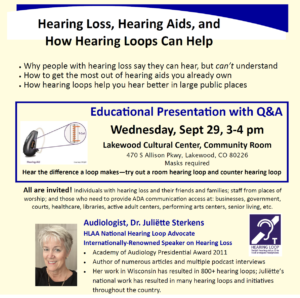
On Wednesday, September 29, 2o21 at 3:00 PM, the Lakewood Cultural Center is hosting internationally renowned speaker and hearing loss expert Juliette Sterkens, for “Hearing Loss, Hearing Aids, and How Hearing Loops Can Help.” The speaking event will be held in the Community Room and conclude with a tour of the main theater and a demonstration of the newly installed hearing loop system, now available for Lakewood theater fans to enjoy.
The event is being co-hosted by Let’s Loop Colorado, a locally hearing loop advocacy group, and Assist2Hear, a leading U.S. installer of induction hearing loops. It coincides with the grand reopening of the Lakewood Cultural Center with its newly installed induction hearing loop system. Village Roasters coffee and light refreshments will be hosted by LCC patron and hearing aid expert, Kevin McConnell of Ideal Hearing. Ideal Hearing will also be on hand to discuss individual hearing aid questions at that time!
The event is free and open to the public! Anyone interested in learning about how to more effectively use their own hearing aids or who would like to learn more about how hearing loop technology can assist them in hearing better in a specific space, such as a theater, church, or other large public space would benefit from attendance.
Lakewood Cultural Center’s hearing loop is funded by the NextFifty Initiative. To purchase tickets to a Lakewood Cultural Center production, go to https://lakewood.showare.com/.
Historic Wheeler Opera House in Aspen, Colorado Installs Hearing Loop System

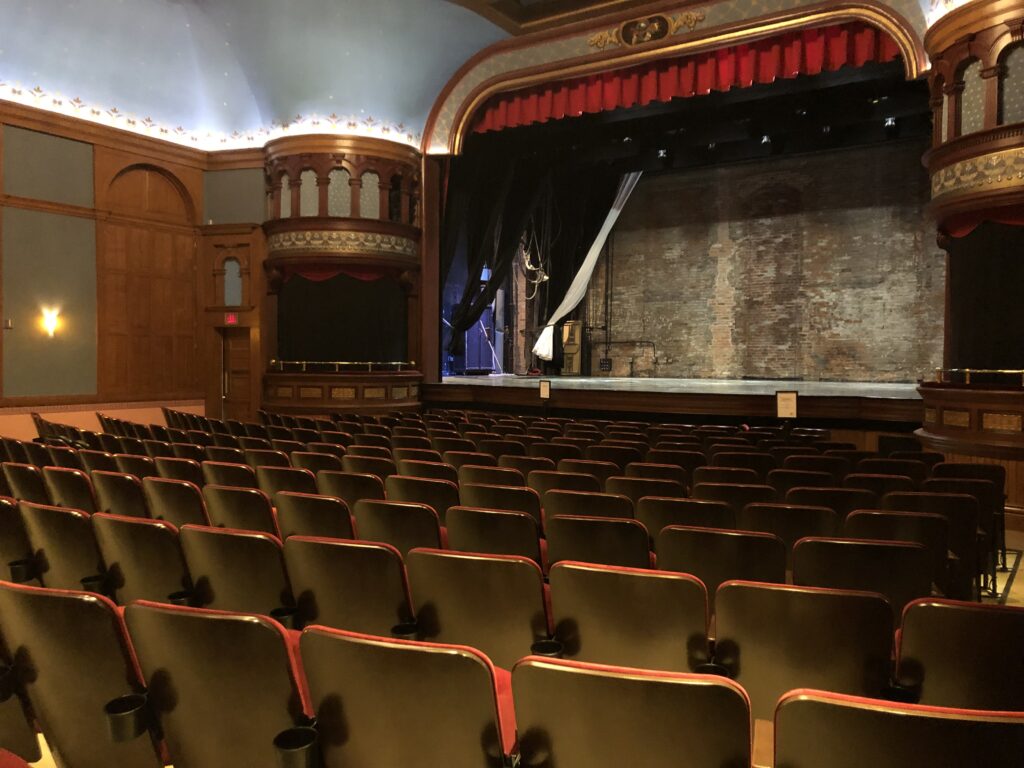

Assist2hear is excited to announce the final completion of another new Colorado hearing loop installation at the Wheeler Opera House in Aspen, Colorado. The installation includes hearing loops in both the orchestra and balcony of the historic Aspen music venue. The décor of the theater now consists of new, lush, carpet in the aisles and original flooring within the seating area of the orchestra, and full carpet in the balcony. The hearing loop design for both segments is a phased array system.
A huge part of hearing loop installation in theaters is maintaining the integrity of a venue’s décor, particularly when working with a historic theater. The Wheeler Opera House opened its doors to the Aspen community in 1889, making it 132-years old today. The necessity for a phased array installation in historic venues such as this requires the experience and custom finishing expertise that only Assist2Hear brings to the table, with over ten years of Contacta field-certified hearing loop installation
Phased arrays hearing loop systems ensure a uniform sound for all users, regardless of seating location. They are a best practice for large theaters due to key factors such as size and rise of seating. The Wheeler Opera House required a phased array design in its orchestra because of the large size and the in the balcony primarily because of its rise. Theater patrons will have to look hard to find any indication of wires, as they are well hid either underneath carpet or seats “disguised as a shadow”.
What does “disguised as a shadow” look like? We hope you will go, enjoy the theater’s new hearing loop, and see for yourself. The Wheeler Opera House reopens its doors to the Aspen Community for the Aspen Music Festival taking place July 1st through August 22nd. For more upcoming events at which to enjoy the Wheeler’s new hearing loop, visit AspenShowTix.com.
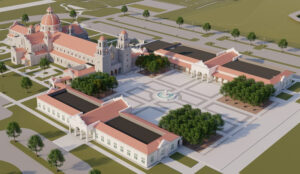
Hearing Loops at New Catholic Shrine Site
Oklahoma Catholics with hearing loss will have the best sound in the house when they worship at the Blessed Stanley Rother Shrine next year. The site will house a 2,000 seat Catholic church, the largest in Oklahoma, as well as the Blessed Stanley Rother shrine and an educational complex. In addition to being the largest Catholic church in Oklahoma, the church and chapel on the shrine site will also include induction hearing loop technology for worshipers. The hearing loop systems will bring the Word of God directly to the ears of Catholic worshipers with hearing loss and eliminate the echo, reverberation, and ambient noise that often make hearing in church extremely difficult.
Why Catholic Churches Need Hearing Loop Technology
Traditionally, Catholic churches are beautifully cavernous structures with high ceilings and hard surfaces. Unfortunately, the construction of these spaces also causes sound to bounce, a factor that no amount of money spent on a sound system can overcome for a person with hearing loss. In these types of spaces, the ability to hear the Word clearly and intelligbly is nearly impossible for people with hearing loss unless a hearing assistive technology, such a s hearing loop, is utilized. With hearing loop technology, all of the peripheral sounds of a space are filtered out and the sound from the audio system comes directly to the user’s ear. With a telecoil-enabled hearing aid, the Word of the Lord comes directly to their hearing aid wearer’s ear, as clearly as if the Father was sitting on their shoulder giving the sermon! The user simply needs to switch their own personal hearing aid to the telecoil program in order to access the technology – there is no need for additional equipment. If a user does not have a telecoil-enabled hearing aid, then utilize a receiver, however, most people enjoy the system by simply using their own hearing aids.

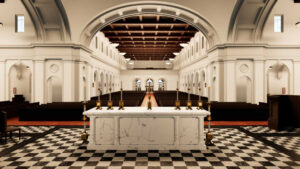
The History of the Blessed Stanley Rother
Father Stanley Rother was born and raised in Okarche, Oklahoma in 1935. He joined the priesthood in 1963, and in the 1970s brought the Word to worshipers in the parish of Santiago Atitlan, Guatemala. While preaching in Guatemala, a civil war between the militarists and guerillas killed thousands of Catholics. Despite the threat to his safety, Father Rother continued to teach the Word and educate the people of Guatemala. In 1981, Father Rother was executed for his refusal to abandon his people in the time of war. He is the first martyer in the United States and the first U.S.-born priest to be beatified, according to the Archdiocese of Oklahoma. His heart remains enshrined in Guatemala to this day. Visit the website of the Archdiocese of Oklahoma at https://www.archokc.org/stanleyrother for his full biography.
Hearing Loops in Oklahoma Catholic Churches
Hearing loops are in many Catholic churches in the Oklahoma City corridor, including St. Thomas Moore in Norman, Holy Spirit in Mustang, and St. Eugene’s in Oklahoma City. When in the Tulsa area, Catholics with hearing can enjoy the Word through hearing loops located at the Catholic Church of St. Mary or Holy Family. Assist2Hear is the installer for all Oklahoma hearing loops listed, with the exception of Holy Family. For more Oklahoma hearing loop locations, click here .
Since 2010, Assist2Hear has been a leading national installer of induction hearing loop systems throughout the U.S. If your church would like a quote on a hearing loop, email us at info@assist2hear.com. For more information on how hearing loops can help people in your church better hear the Word, please visit our blog post Hearing Loop Systems in Churches.
For more information on the Blessed Stanley Rother Shrine, please visit the Catholic Diocese of Oklahoma’s dedicated page at https://archokc.org/shrine.
Hearing loops in library systems are an essential part of reducing barriers to services for library patrons. Without hearing loops in library systems, persons living with hearing loss can find library services difficult or embarrassing to utilize.
What is the first rule of thumb in a library? Be quiet! Now imagine having hearing loss and attempting to communicate in a library. Perhaps you are at the information desk and you asking where a specific book is located. The librarian will provide detailed instructions, in a soft tone, because that’s what you do in a library – talk quietly. Unfortunately speaking softly makes for an incredibly challenging situation for persons living with hearing loss. In the library, a conversation in an elevated volume brings disapproving eyes and a “shhhhh!”
Hearing loops in library systems are an essential part of reducing barriers to services for library patrons. Without hearing loops in library systems, persons living with hearing loss can find library services difficult or embarrassing to utilize. The information desk is just one of many locations where hearing loops can help users hear better in libraries. Library hearing loop systems should be present in a variety of forms, such as large area hearing loop systems in public meeting rooms and small area loop systems, such as counter loops at information desks.
One of the most common locations for hearing loops in a library is the community or meeting room. Most libraries have meeting room(s) that are available to the public for use to host or engage in seminars, trainings, and even government functions, such as such as city council meetings. Most of these rooms also have a microphone and/or audio-visual system in them, which means they are also legally required to offer hearing assistive technology to users to meet ADA regulations related to access for persons with hearing loss. In new libraries, hearing loops are becoming the standard hearing assistive technology offered because of the high level of user-satisfaction and the ability for patrons to use the system without the librarian or library workers having to maintain and checkout additional equipment.
It is essential for librarians and library workers to assess their local library resources to make sure that hearing assistive technology is present for the community. A counter hearing loop is a very cost-effective way to help persons with hearing loss access the basic services of the library. If a large area hearing loop is not in the library budget now, a lower cost system such as FM or IR may be a short-term solution to ensure compliance with the ADA and make sure that all library patrons can access services, such as use of the community room.
Assist2Hear has installed hearing loops in many library systems. In the Front Range of Colorado, these hearing loop locations include:
- Douglas County Library system (Parker, Highlands Ranch, Castle Rock, and Castle Pines, CO)
- Old Towne Library (Fort Collins, CO)
- Pikes Peak 21C Library (Colorado Springs, CO)
For more information about what it takes to install a hearing loop in your local library, give Assist2Hear a call today! We offer the free site assessments for hearing loop systems and can also provide you with a demonstration counter loop to test at the information desk or other point of service. Additionally, Assist2Hear also offers training resources to library staff about hearing loss and how to effectively communicate with persons with hearing loss.

